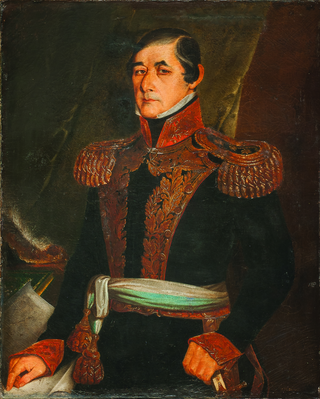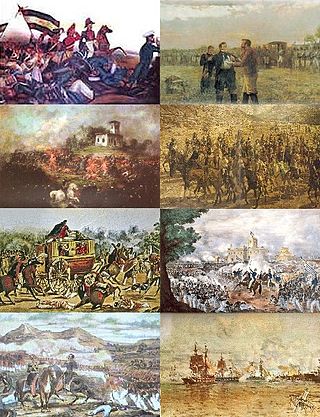| Landing of the 33 Patriots Day | |
|---|---|
| Observed by | Uruguay |
| Date | 19 April |
| Next time | 19 April 2024 |
| Frequency | annual |
19 April is the anniversary of the Landing of the 33 Patriots in Uruguay, also known as the Thirty-Three Orientals, called 'Orientals' because Uruguay was known as the Banda Oriental, or the "Eastern Bank" of the Río de la Plata, the western shore being Argentina.
In a span of less than ten years—1807 to 1816—the Banda Oriental and its capital city of Montevideo were occupied by the English, retaken by the Spanish, and invaded by the Portuguese.
In 1816 Portuguese Brazil took Banda Oriental from the north, ousting the province's hero José Gervasio Artigas in 1820 and forcing him into exile in Paraguay. Banda Oriental became a province of Brazil, which achieved independence from Portugal in 1822.
In 1825 a group of exiled Uruguayan fighters called the 33 Orientals returned from Buenos Aires. They were led by Juan Antonio Lavalleja, who had fought with the exiled Artigas. The 33 Orientals secretly crossed the Plata River, landing on the Eastern Bank on 19 April. There they planted what would be known as the flag of the 33 Orientals and took an oath to kick the Brazilian government out of Uruguay.
Four months later, on 25 August 1825, Uruguay officially declared its independence from Brazil. After 500 days of fighting (the Argentina–Brazil War), Brazil recognized Uruguay's independence in 1828.
Celebrations held on this date correspond with celebrations held on their National Independence day, with the laying of wreaths, speeches, and particularly special prayer programs held in churches all over Uruguay, recognizing the 33 brave men who had sparked the revolution towards their independence.

José Gervasio Artigas Arnal was a soldier and statesman who is regarded as a national hero in Uruguay and the father of Uruguayan nationhood.

The Argentine War of Independence was a secessionist civil war fought from 1810 to 1818 by Argentine patriotic forces under Manuel Belgrano, Juan José Castelli, Martin Miguel de Guemes and José de San Martín against royalist forces loyal to the Spanish crown. On July 9, 1816, an assembly met in San Miguel de Tucumán, declaring independence with provisions for a national constitution.

Manuel Ceferino Oribe y Viana was the 2nd Constitutional president of Uruguay and founder of Uruguay's National Party, the oldest Uruguayan political party and considered one of the two Uruguayan "traditional" parties, along with the Colorado Party, which was, until the 20th century, its only political adversary.

José Fructuoso Rivera y Toscana was an Uruguayan general and patriot who fought for the liberation of Banda Oriental from Brazilian rule, thrice served as President of Uruguay and was one of the instigators of the long Uruguayan Civil War. He is also considered to be the founder of the Colorado Party, which ruled Uruguay without interruption from 1865 until 1958. He made a controversial decision to almost completely eliminate the native Charrúa during the 1831 Massacre of Salsipuedes.
Banda Oriental, or more fully Banda Oriental del Uruguay, was the name of the South American territories east of the Uruguay River and north of Río de la Plata that comprise the modern nation of Uruguay, the modern state of Rio Grande do Sul, Brazil, and part of the modern state of Santa Catarina, Brazil. It was the easternmost territory of the Viceroyalty of the Río de la Plata.

The United Provinces of the Río de la Plata, earlier known as the United Provinces of South America, was a name adopted in 1816 by the Congress of Tucumán for the region of South America that declared independence in 1816, with the Sovereign Congress taking place in 1813, during the Argentine War of Independence (1810–1818) that began with the May Revolution in 1810. It originally comprised rebellious territories of the former Spanish Viceroyalty of the Río de la Plata dependencies and had Buenos Aires as its capital.

The Cisplatine War, was an armed conflict fought in the 1820s between the Empire of Brazil and the United Provinces of the Río de la Plata over Brazil's Cisplatina province. It was fought in the aftermath of the United Provinces' and Brazil's independence from Spain and Portugal, respectively, and resulted in the independence of Cisplatina as the Oriental Republic of Uruguay.

The Treinta y Tres Orientales was a revolutionary group led by Juan Antonio Lavalleja and Manuel Oribe against the Empire of Brazil. Their actions culminated in the foundation of modern Uruguay. They became famous by the name of the Treinta y Tres Orientales when, in 1825, they began an insurrection for the independence of Oriental Province, a historical territory encompassing modern Uruguay and part of modern Brazilian Rio Grande do Sul State, from Brazilian control.

The Federal League, also known as the League of the Free Peoples, was an alliance of provinces in what is now Uruguay, Argentina and Brazil that aimed to establish a confederal organization for the state that was emerging from the May Revolution in the war of independence against the Spanish Empire.

Cisplatina was a Brazilian province in existence from 1821 to 1828 created by the Luso-Brazilian invasion of the Banda Oriental. From 1815 until 1822 Brazil was a constituent kingdom of the United Kingdom of Portugal, Brazil and the Algarves. After the independence of Brazil and the formation of the Empire of Brazil the Cisplatina province remained part of it. In 1828, following the Preliminary Peace Convention, the Cisplatina province became independent as Uruguay.

Brazil–Uruguay relations encompass many complex relations over the span of three centuries, beginning in 1680 with the establishment of the Colónia do Sacramento, to the present day, between the Federative Republic of Brazil and the Oriental Republic of Uruguay. Brazil and Uruguay are neighbouring countries in South America, and share close political, economic and cultural ties. The singularity of the bilateral relationship between the two countries originates from a strong historical connection, as both countries having been territories of the Portuguese Empire and sharing the same language – marked by important events, such as the establishment of the Colónia do Sacramento in 1680, the invasion of the Banda Oriental by Brazil in 1815 and the subsequent creation of the Província Cisplatina, and Uruguay's independence from Brazil in 1828. The bilateral relationship was further defined by the Uruguayan Civil War (1839–1851) and the Paraguayan War (1864–1870).
The Portuguese conquest of the Banda Oriental was the armed-conflict that took place between 1816 and 1820 in the Banda Oriental, for control of what today comprises the whole of the Republic of Uruguay, the northern part of the Argentine Mesopotamia and southern Brazil. The four-year armed-conflict resulted in the annexation of the Banda Oriental into the United Kingdom of Portugal, Brazil and the Algarves as the Brazilian province of Cisplatina.
The Preliminary Peace Convention was a bilateral treaty signed on 27 August 1828 between the Empire of Brazil and the United Provinces of the Río de la Plata, after British mediation, that put an end to the Cisplatine War and recognized the independence of Uruguay.

Manuel de Sarratea,, was an Argentine diplomat, politician and soldier. He was the son of Martín de Sarratea (1743–1813), of the richest merchant of Buenos-Aires and Tomasa Josefa de Altolaguirre. His sister Martina de Sarrateas (1772–1805) married Santiago de Liniers, vice-roy del Rio de la Plata.

Spain–Uruguay relations are the current and historical relations between Spain and Uruguay. There is community of 67,000 Spanish nationals residing in Uruguay and 33,000 Uruguayan nationals residing in Spain. Both nations are members of the Association of Spanish Language Academies, Organization of Ibero-American States and the United Nations.

The Argentine Civil Wars were a series of civil conflicts of varying intensity that took place through the territories of Argentina from 1814 to 1853. Beginning concurrently with the Argentine War of Independence (1810–1818), the conflict prevented the formation of a stable governing body until the signing of the Argentine Constitution of 1853, followed by low-frequency skirmishes that ended with the Federalization of Buenos Aires. The period saw heavy intervention from the Brazilian Empire that fought against state and provinces in multiple wars. Breakaway nations, former territories of the viceroyalty, such as the Banda Oriental, Paraguay and the Upper Peru were involved to varying degrees. Foreign powers such as the British and French empires put heavy pressure on the fledgling nations at times of international war.

Francisco Ramírez, also known as "Pancho" Ramírez as well as "El Supremo Entrerriano" (1786–1821), was an Argentine governor of Entre Ríos during the Argentine War of Independence.
The rise of the Argentine Republic was a process that took place in the first half of the 19th century in Argentina. The Republic has its origins on the territory of the Viceroyalty of the Río de la Plata, a colony of the Spanish Empire. The King of Spain appointed a viceroy to oversee the governance of the colony. The 1810 May Revolution staged a coup d'état and deposed the viceroy and, along with the Argentine war of independence, started a process of rupture with the Spanish monarchy with the creation of an independent republican state. All proposals to organize a local monarchy failed, and no local monarch was ever crowned.

The dissolution of the Viceroyalty of the Río de la Plata meant the breakup of the Spanish colony in South America and the creation of new independent countries. Most of the territory of the Spanish viceroyalty is now part of Argentina, and other regions belong to Bolivia, Brazil, Paraguay and Uruguay.

The Argentina–Uruguay border is a line of 579 km marked by the Uruguay River, and is the border between Argentina and Uruguay. It starts in a triple border Argentina-Uruguay-Brazil, at the mouth of the Quaraí River in the Uruguay. The course follows the Uruguay river, passing west of the Uruguayan departments of Artigas, Salto, Paysandu, Rio Negro, Soriano and Colonia and the Argentine provinces of Corrientes, Entre Rios and Buenos Aires, until the confluence of the Uruguay and the Paraná rivers into the Rio de la Plata.